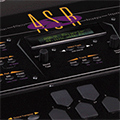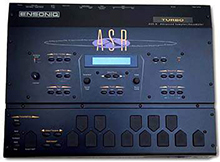 Ensoniq have made a brave move with this hybrid sampler, because in deciding to enter the Akai-dominated sampling workstation market they could have come unstuck rather than coming up trumps. Although the MPC2000 may be more highly specified in the sampling department, it doesn’t offer the ASRX’s built-in ROM sounds, effects as standard, or resampling.
Ensoniq have made a brave move with this hybrid sampler, because in deciding to enter the Akai-dominated sampling workstation market they could have come unstuck rather than coming up trumps. Although the MPC2000 may be more highly specified in the sampling department, it doesn’t offer the ASRX’s built-in ROM sounds, effects as standard, or resampling.
X-RAY SPECS
The Ensoniq ASRX is a pro-specification 16-bit stereo sampler/resampler, with built-in MR synthesizer, multi-effects, 18dB resonant filters, 32-voice polyphony, a multitimbral, 16-track MIDI sequencer, 14 real-time performance pads, 2Mb of RAM and a floppy disk drive. The unit can be expanded with a further 26Mb of ROM voices and 32Mb of RAM, and an optional expander board offers an additional eight assignable audio outputs and a SCSI facility.
Although described by Ensoniq as a portable unit, the ASRX is a substantial beast, in terms of both its build quality and its size. The pressed steel casing measures about 17 x 13 x 4 (inches) and, apart from a couple of slightly flimsy protruding controls on the back, looks and feels as if it were built for life on the road. The expansive front panel is divided into two sections and contains a small, backlit, 2-line x 20-character LCD and 40 or so controls. In the upper section is a volume control and two continuously variable knobs labelled Parameter/Sound Type and Value/Sound Name. The Parameter knob is for scrolling through sound banks and browsing parameter pages. The Value control is used to scroll through sound names (within sound banks) and to change parameter values. Unfortunately, there are no +/- incremental buttons for fine-tuning values, nor any way of making large parameter leaps, which means that a lot of knob-twiddling is the order of the day.
 Some of the 21 small oval push-buttons have useful built-in LEDs, and many of them perform multiple functions — some can call up a parameter page when you double-click on them, as you would using a mouse with a computer, and repeatedly clicking causes some of the buttons to scroll through parameter pages, so that you don’t have to use the parameter knob. Both these methods take a little getting used to, but do open the way to some useful and speedy programming shortcuts. The lower half of the front panel contains the sampling section, transpose and Patch Select buttons (see ‘Patch It Up’ box), and 14 velocity-sensitive pads.
Some of the 21 small oval push-buttons have useful built-in LEDs, and many of them perform multiple functions — some can call up a parameter page when you double-click on them, as you would using a mouse with a computer, and repeatedly clicking causes some of the buttons to scroll through parameter pages, so that you don’t have to use the parameter knob. Both these methods take a little getting used to, but do open the way to some useful and speedy programming shortcuts. The lower half of the front panel contains the sampling section, transpose and Patch Select buttons (see ‘Patch It Up’ box), and 14 velocity-sensitive pads.
On the rear panel are jack sockets for left and right audio inputs and outputs, a stereo headphone socket, a dual footswitch socket, MIDI In/Out/Thru connectors, an input-level control, a mic/line input selector switch, and a couple of blank panels waiting for the various upgrade options.
THE SOUND OF WAVES
In operation the ASRX follows most sampler, synth and sequencer conventions and, apart from a few quirks and idiosyncrasies, is fairly straightforward to use. One of these quirks is the lack of a battery-backed system, patch or performance memory, which means that a stash of floppies should always be close to hand, for quick saving of any edits.
Raw samples and ROM voices in the ASRX are called Waves, while programmes or performances containing them are, a little confusingly, called either Kit Sounds or Standard Sounds. Standard Sounds are made up of a maximum of 16 layers of individual mono or stereo waves spread chromatically across the front-panel pads. A Standard Sound can be used for anything melodic — from synth, bass, guitar or samples, through to highly complex evolving pads or sound effects. Bear in mind, though, that preset ROM Sounds using a lot of layers steal notes from the total 32-note polyphony. Kit Sounds utilise a structure where each note, from B1 to D7, can play an entirely different mono or stereo wave. You could have a mixture of 64 percussion sounds, sample loops, Standard Sounds or even other Kit Sounds programmed onto individual pads or MIDI notes.